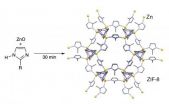(Press-News.org) New research has demonstrated a way to make bismuth electrons and nuclei work together as qubits in a quantum computer.
The discovery, published in Nature Materials, takes us a key step further to creating practical quantum computing which could tackle complex programs that would otherwise take the lifetime of the universe to finish.
The collaboration partners are based in the University of Warwick, UCL, ETH Zurich and the USA Sandia National Labs.
Information on our normal computers is stored as bits, which are either ones or zeros. Quantum bits work differently in that each quantum bit can try out being a one and a zero at the same time, which makes them much more powerful for solving certain problems.
Researchers have explored influencing the direction of spin in electrons to create those states but this approach has had its challenges.
Dr Gavin Morley from the University of Warwick's Department of Physics said: "Bismuth atoms in silicon crystals are great at working as quantum bits. Each bismuth atom has a spare electron, which has a "spin" that can be influenced by magnets.
"If we put the electron into a magnet, it lines up with the magnetic field, behaving like a compass needle.
"We can control the direction that the electron is pointing in, using microwaves. Microwaves let us flip the direction the electron is pointing in, and these "up and down" directions are what constitute the "one and zero" in our quantum bit.
"Unfortunately, our electron is constantly prone to interference from nearby atoms that are out of our control.
"And the more time we waste, the greater the chance that our poor electron will suffer from interference, making it unusable to us."
"Now, this electron is coupled to the bismuth nucleus, which has its own spin: a smaller compass needle. Using this as an extra quantum bit and flipping it at the same time as our electron, would really help out. We can control this smaller compass needle too, but as it's smaller, it takes longer to control, and we need to use radiowaves instead of microwaves to do this."
"The good news is that as it's slow to respond, our bismuth nucleus's smaller compass needle suffers less from interference by nearby rogue atoms than our electron's larger compass needle. Unfortunately in the time we spend controlling our bismuth nucleus, these rogue atoms interfere with our electron."
"However we found that if we reduce the magnetic field just enough, then the electron and the nucleus become hybridized. Our new experiments at ETH Zurich show that through hybridisation, we can flip both compass needles easily using microwaves."
Dr Morley compares it to the magnetic resonance imaging we find in hospitals.
He said: "MRI works by controlling the nuclear spins in your body.
"We have hybridized electron and nuclear spins and found that this makes it easier to control them.
"It's an easy new way to make slow and fast quantum bits work together. There are lots more challenges to face before anyone has a working computer with enough quantum bits to be useful, but with this hybridization as part of a computer's design, we are one step closer."
###
The paper entitled "Quantum control of hybrid nuclear–electronic qubits" is published in Nature Materials doi: 10.1038/NMAT3499 (2012) and is by Gavin W Morley, Petra Lueders, M Hamed Mohammady, Setrak J Balian, Gabriel Aeppli, Christopher WM Kay, Wayne M Witzel, Gunnar Jeschke & Tania S Monteiro, Nature Materials doi: 10.1038/NMAT3499 (2012).
Contacts
Gavin Morley, Department of Physics, University of Warwick. gavin.morley@warwick.ac.uk tel 44-2476-150-801 or 44-7894-984-021
Anna Blackaby, University of Warwick press officer
Image
Hybridizing electronic and nuclear spin qubits makes quantum control much easier. This equation, spelt out in child's plastic letters on a fridge, describes the pure states of bismuth-doped silicon for which the nuclear and electronic qubits become maximally hybridized at specific magnetic fields.
http://www2.warwick.ac.uk/services/communications/medialibrary/images/november2012/childs_equation.jpg
END
Anthrax uses a receptor on the surface of cells to inject its lethal toxins. However, the physiological function of this receptor, named Anthrax Toxin Receptor 2a (Antxr2a), remained unknown until now. A team led by Marcos Gonzalez-Gaitan, a professor at the University of Geneva (UNIGE), Switzerland, in collaboration with Gisou van der Goot at EPFL (École Polytechnique Fédérale de Lausanne), reveals that Antxr2a actually plays a role in embryonic development, orienting cell division along a specific plane, which is a prelude to the formation of future tissues and organs. ...
Using powerful gene-analysis tools, researchers have discovered mutations in two related genes, ARID1A and ARID1B, that are involved in the most aggressive form of the childhood cancer neuroblastoma. While these findings do not immediately improve clinical treatments, they identify a novel pathway that is defective in these cancers, a pathway that scientists can now study to develop potential new therapies.
"These gene alterations were not previously known to be mutated in neuroblastoma, and they may significantly advance our knowledge of the underlying biological pathways ...
An international team of genetics researchers has discovered four new gene regions that contribute to low birth weight. Three of those regions influence adult metabolism, and appear to affect longer-term outcomes such as adult height, risk of type 2 diabetes and adult blood pressure.
"This large study adds to the evidence that genes have a strong influence on fetal growth," said one of the co-authors, Struan F.A. Grant, Ph.D., associate director of the Center for Applied Genomics at The Children's Hospital of Philadelphia. "The cumulative effect of the genes is surprisingly ...
LA JOLLA, CA – December 2, 2012 – Scientists at The Scripps Research Institute (TSRI) have determined how two proteins help create organelles, or specialized subunits within a cell, that play a vital role in maintaining cell health. This discovery opens the door for research on substances that could interfere with the formation of these organelles and lead to new therapies for cancer.
The study, published online ahead of print on December 2, 2012, by the journal Nature Structural & Molecular Biology, focuses on the structure and function of the two proteins, ATG12 and ...
In a genome sequencing study of 74 neuroblastoma tumors in children, scientists at the Johns Hopkins Kimmel Cancer Center and the Children's Hospital of Philadelphia (CHOP) found that patients with changes in two genes, ARID1A and ARID1B, survive only a quarter as long as patients without the changes. The discovery could eventually lead to early identification of patients with aggressive neuroblastomas who may need additional treatments.
Neuroblastomas affect nerve tissue throughout the body and are the most common, non-blood cancer in children. "These cancers have a ...
Scientists have discovered for the first time how humans – and other mammals – have evolved to have intelligence.
Researchers have identified the moment in history when the genes that enabled us to think and reason evolved.
This point 500 million years ago provided our ability to learn complex skills, analyse situations and have flexibility in the way in which we think.
Professor Seth Grant, of the University of Edinburgh, who led the research, said: "One of the greatest scientific problems is to explain how intelligence and complex behaviours arose during evolution." ...
This press release is available in German.
Abused children are at high risk of anxiety and mood disorders, as traumatic experience induces lasting changes to their gene regulation. Scientists from the Max Planck Institute of Psychiatry in Munich have now documented for the first time that genetic variants of the FKBP5 gene can influence epigenetic alterations in this gene induced by early trauma. In individuals with a genetic predisposition, trauma causes long-term changes in DNA methylation leading to a lasting dysregulation of the stress hormone system. As a result, ...
Solvents are omnipresent in the chemical industry, and are a major environmental and safety concern. Therefore the large interest in mechanochemistry: an energy-efficient alternative that avoids using bulk solvents and uses high-frequency milling to drive reactions. Milling is achieved by the intense impact of steel balls in a rapidly moving jar, which hinders the direct observation of underlying chemistry. Scientists have now for the first time studied a milling reaction in real time, using highly penetrating X-rays to observe the surprisingly rapid transformations as ...
CAMBRIDGE, Mass. (December 2, 2012) –Whitehead Institute scientists report that certain molecules present in high concentrations on the surfaces of many cancer cells could be exploited to funnel lethal toxic molecules into the malignant cells. In such an approach, the overexpression of specific transporters could be exploited to deliver toxic substances into cancer cells.
Although this finding emerges from the study of a single toxic molecule and the protein that it transports, Whitehead Member David Sabatini says this phenomenon could be leveraged more broadly.
"Our ...
MAYWOOD, Il. - A Loyola University Medical Center neurologist is reporting surprising results of a study of patients who experience both epileptic and non-epileptic seizures.
Non-epileptic seizures resemble epileptic seizures, but are not accompanied by abnormal electrical discharges. Rather, these seizures are believed to be brought on by psychological stresses.
Dr. Diane Thomas reported that 15.7 percent of hospital patients who experienced non-epileptic seizures also had epileptic seizures during the same hospital stay. Previous studies found the percentage of such ...


